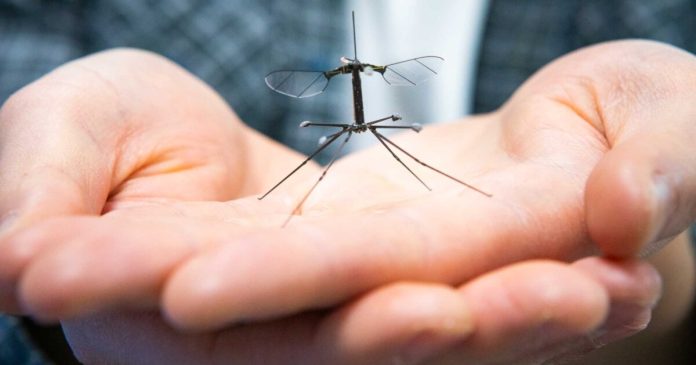Even if you’ve built one of the world’s most advanced insect-inspired micro air vehicles (MAVs), it ultimately won’t be that useful if it can’t stick a good landing. That’s why scientists at Harvard University have now given their RoboBee a set of long, jointed legs much like those of the crane fly.
For those of you who are unfamiliar with the RoboBee, it’s a bee-inspired robot that flies by flapping a tiny pair of artificial-muscle-equipped wings. It has a wingspan of less than 3 cm (1.2 in) and weighs only about a tenth of a gram … although it is connected to a power source and a microprocessor via a wire.
That said, future versions may ultimately be fully self-contained. In fact, there’s already one variant that’s solar-powered.
Although other incarnations of the little robot have proven capable of feats such as flying underwater and perching on overhangs, the base model has never been that great at simply landing on flat (or other) surfaces. This is because vortices created by its flapping wings cause air turbulence as they become confined against the ground, which can in turn knock the bot off balance.
“Previously, if we were to go in for a landing, we’d turn off the vehicle a little bit above the ground and just drop it, and pray that it will land upright and safely,” says engineering graduate student Christian Chan, who led the mechanical redesign of the robot.
.
Image content
.
.
The RoboBee’s four new crane-fly-inspired legs are long and flexible enough that they can all safely make contact with the ground before the bot’s main body becomes affected by the ground effect turbulence.
Additionally, a new control algorithm helps guide the robot more smoothly to the ground, instead of allowing it to “just drop.”
.
Image content
.
.
“Seeking bioinspiration within the amazing diversity of insects offers us countless avenues to continue improving the robot,” says postdoctoral researcher Alyssa Hernandez, co-author of a paper on the study. “Reciprocally, we can use these robotic platforms as tools for biological research, producing studies that test biomechanical hypotheses.”
The paper was recently published in the journal Science Robotics. You can see the RoboBee in crane-fly-inspired landing action, in a video.
.
Video content
.
.
Source: Harvard John A. Paulson School of Engineering and Applied Sciences




